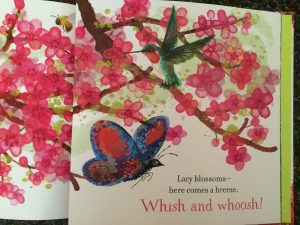
Author(s): Byrd Baylor
Illustrator/Photographer: Peter Parnall
Publisher and Year: First Aladdin Paperbacks edition July 1998
Number of Pages: 27
Genre: Fiction, Poetry
Analysis:
This story is about a little girl, nicknamed Mountain Girl by her parents, who begins the book by stating that her family is not rich but her parents seem to disagree with her. She believes that their kitchen table her parents made is not a table where rich people would sit, because it is not fancy or luxurious. After calling together a family meeting about the financial state they are in, she soon begins to realize that her family is rich in experiences and opportunities and that this is even more valuable than being rich in money.
This book provides the opportunity for children to learn and discuss poverty, but it also provides the platform that being rich is not the only way to be happy. This book allows children to look at their own lives as well and recognize all the experiences they have had that makes them rich. The text of the book does not directly address a particular race or ethnicity, but they do mention that the children were born in Arizona and Mexico and the illustrations depict a family that lives in an area with mountains, cacti, sunshine, animals, and deserts. However, I believe that this story is a criticism of the fast-paced and industrial culture of the U.S. that has been engrained in our society, even among children, who now associate money with success and happiness. The more nature-loving culture in this book is praised because they do not believe that too much value should be placed on material items.
The illustrations in this book are very powerful and emphasize the importance of nature and family. In all the illustrations the characters, scenery, and objects are all connected in some way, which reinforces the idea that this family is very in touch with nature, but also that nature is extremely valuable because it is in every image. This story challenges the idea that the only way to be rich is if you have a lot of money, and it does a great job of showing how Mountain Girl has slowly come to realize that being in nature and all the experiences her family has had in their current job are what makes someone rich.


![2016-05-10_00.50.24[1]](https://blogs.iwu.edu/lrbmt2016/files/2016/05/2016-05-10_00.50.241-300x239.jpg)
![2016-05-10_00.49.13[1]](https://blogs.iwu.edu/lrbmt2016/files/2016/05/2016-05-10_00.49.131-300x264.jpg)


![IMG_9611 [405969]](https://blogs.iwu.edu/lrbmt2016/files/2016/05/IMG_9611-405969-300x210.jpg) Authors: Phillip and Hannah Hoose
Authors: Phillip and Hannah Hoose![IMG_9613 [405970]](https://blogs.iwu.edu/lrbmt2016/files/2016/05/IMG_9613-405970-300x148.jpg) Analysis:“Hey, Little Ant” is a story about a child that contemplates whether or not he should spare an ant’s life. After putting himself in the ant’s shoes, the boy sees that maybe he shouldn’t squish the bug after all. This text could primarily work as a window. It is common in America to carelessly step on small bugs, such as ants. This book could give us a glimpse of the bug’s perspective. This book also allows children to step out of the egocentric world that they live in, where everything is “I view it this way, so that’s how it must be.” In the story, the power somewhat shifts from the big and mighty kid to the ant, who ultimately could’ve convinced the boy not to step on him. When the ant tells the kid to imagine that he was the ant and the ant the kid, the boy starts to feel for the ant.
Analysis:“Hey, Little Ant” is a story about a child that contemplates whether or not he should spare an ant’s life. After putting himself in the ant’s shoes, the boy sees that maybe he shouldn’t squish the bug after all. This text could primarily work as a window. It is common in America to carelessly step on small bugs, such as ants. This book could give us a glimpse of the bug’s perspective. This book also allows children to step out of the egocentric world that they live in, where everything is “I view it this way, so that’s how it must be.” In the story, the power somewhat shifts from the big and mighty kid to the ant, who ultimately could’ve convinced the boy not to step on him. When the ant tells the kid to imagine that he was the ant and the ant the kid, the boy starts to feel for the ant.